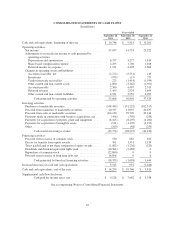Apple 2013 Annual Report Download - page 56
Download and view the complete annual report
Please find page 56 of the 2013 Apple annual report below. You can navigate through the pages in the report by either clicking on the pages listed below, or by using the keyword search tool below to find specific information within the annual report.
Earnings Per Share
Basic earnings per share is computed by dividing income available to common shareholders by the weighted-
average number of shares of common stock outstanding during the period. Diluted earnings per share is computed
by dividing income available to common shareholders by the weighted-average number of shares of common stock
outstanding during the period increased to include the number of additional shares of common stock that would
have been outstanding if the potentially dilutive securities had been issued. Potentially dilutive securities include
outstanding stock options, shares to be purchased under the Company’s employee stock purchase plan and unvested
RSUs. The dilutive effect of potentially dilutive securities is reflected in diluted earnings per share by application of
the treasury stock method. Under the treasury stock method, an increase in the fair market value of the Company’s
common stock can result in a greater dilutive effect from potentially dilutive securities.
The following table shows the computation of basic and diluted earnings per share for 2013, 2012, and 2011 (in
thousands, except net income in millions and per share amounts):
2013 2012 2011
Numerator:
Net income ................................................. $ 37,037 $ 41,733 $ 25,922
Denominator:
Weighted-average shares outstanding ............................ 925,331 934,818 924,258
Effect of dilutive securities .................................... 6,331 10,537 12,387
Weighted-average diluted shares ................................ 931,662 945,355 936,645
Basic earnings per share ........................................... $ 40.03 $ 44.64 $ 28.05
Diluted earnings per share ......................................... $ 39.75 $ 44.15 $ 27.68
Potentially dilutive securities representing 4.2 million, 1.0 million and 1.7 million shares of common stock for
2013, 2012 and 2011, respectively, were excluded from the computation of diluted earnings per share for these
periods because their effect would have been antidilutive.
Financial Instruments
Cash Equivalents and Marketable Securities
All highly liquid investments with maturities of three months or less at the date of purchase are classified as cash
equivalents. The Company’s marketable debt and equity securities have been classified and accounted for as
available-for-sale. Management determines the appropriate classification of its investments at the time of
purchase and reevaluates the designations at each balance sheet date. The Company classifies its marketable debt
securities as either short-term or long-term based on each instrument’s underlying contractual maturity date.
Marketable debt securities with maturities of 12 months or less are classified as short-term and marketable debt
securities with maturities greater than 12 months are classified as long-term. The Company classifies its
marketable equity securities, including mutual funds, as either short-term or long-term based on the nature of
each security and its availability for use in current operations. The Company’s marketable debt and equity
securities are carried at fair value, with the unrealized gains and losses, net of taxes, reported as a component of
shareholders’ equity. The cost of securities sold is based upon the specific identification method.
Derivative Financial Instruments
The Company accounts for its derivative instruments as either assets or liabilities and carries them at fair value.
For derivative instruments that hedge the exposure to variability in expected future cash flows that are designated as
cash flow hedges, the effective portion of the gain or loss on the derivative instrument is reported as a component of
accumulated other comprehensive income (“AOCI”) in shareholders’ equity and reclassified into income in the
same period or periods during which the hedged transaction affects earnings. The ineffective portion of the gain or
54
























